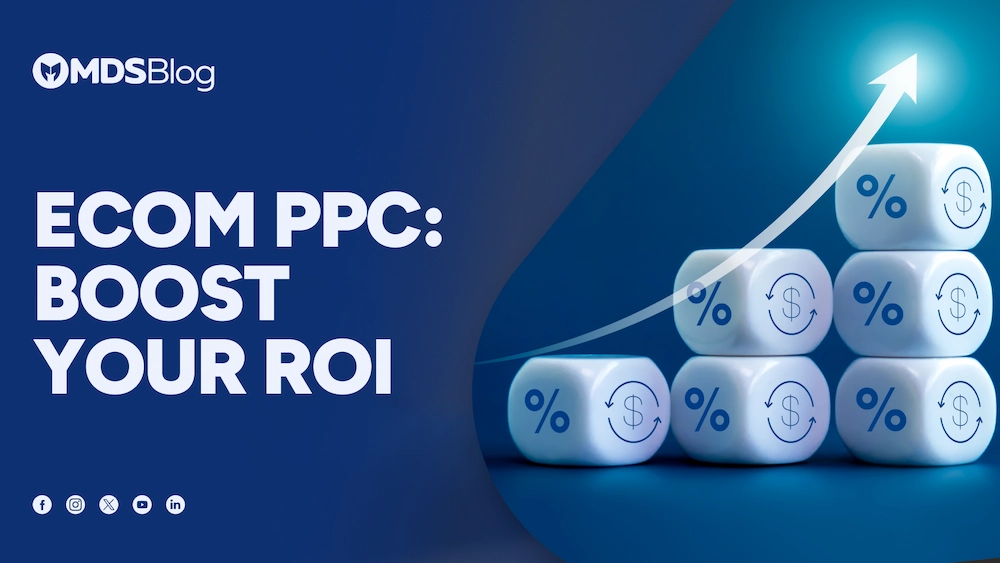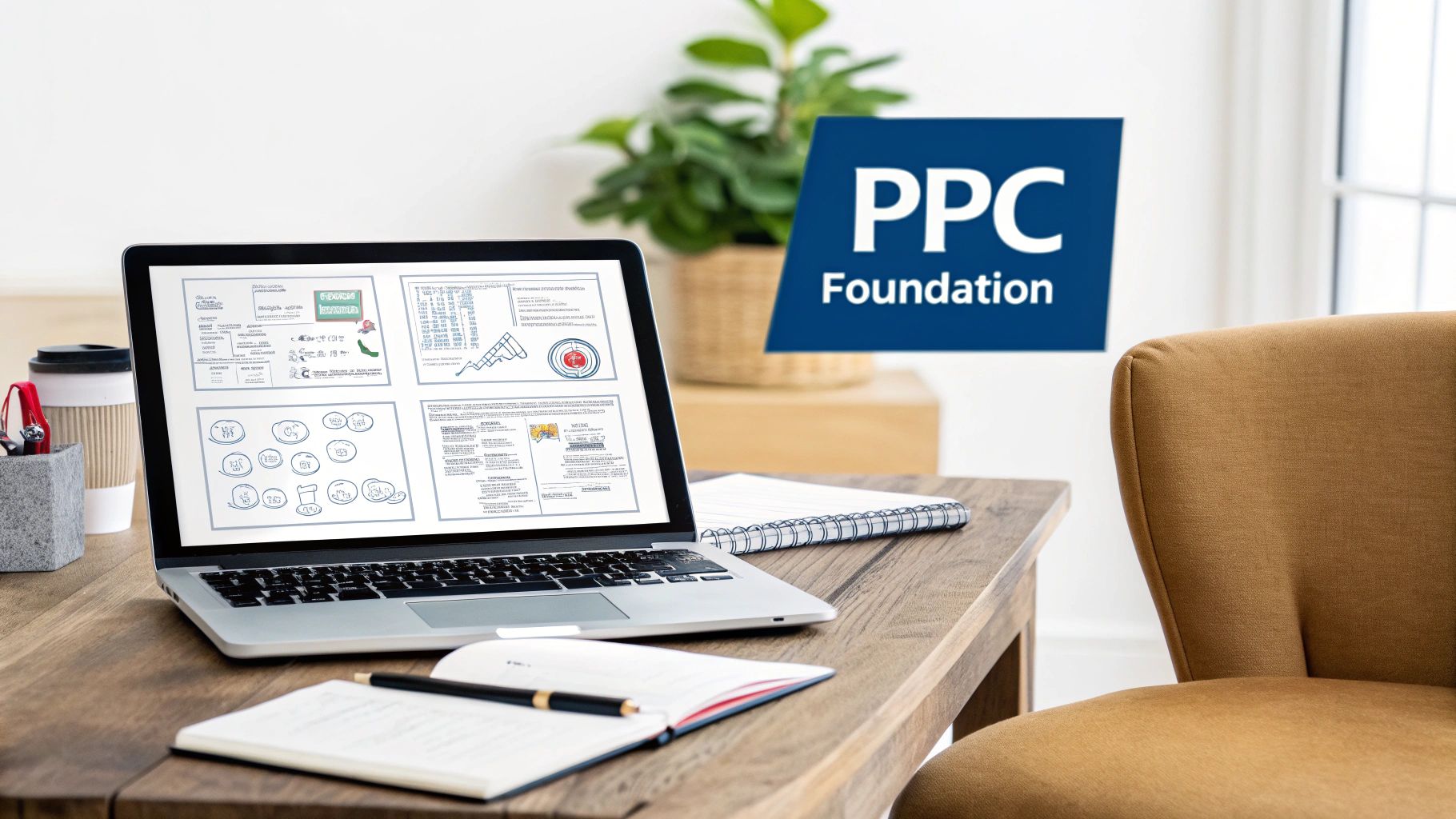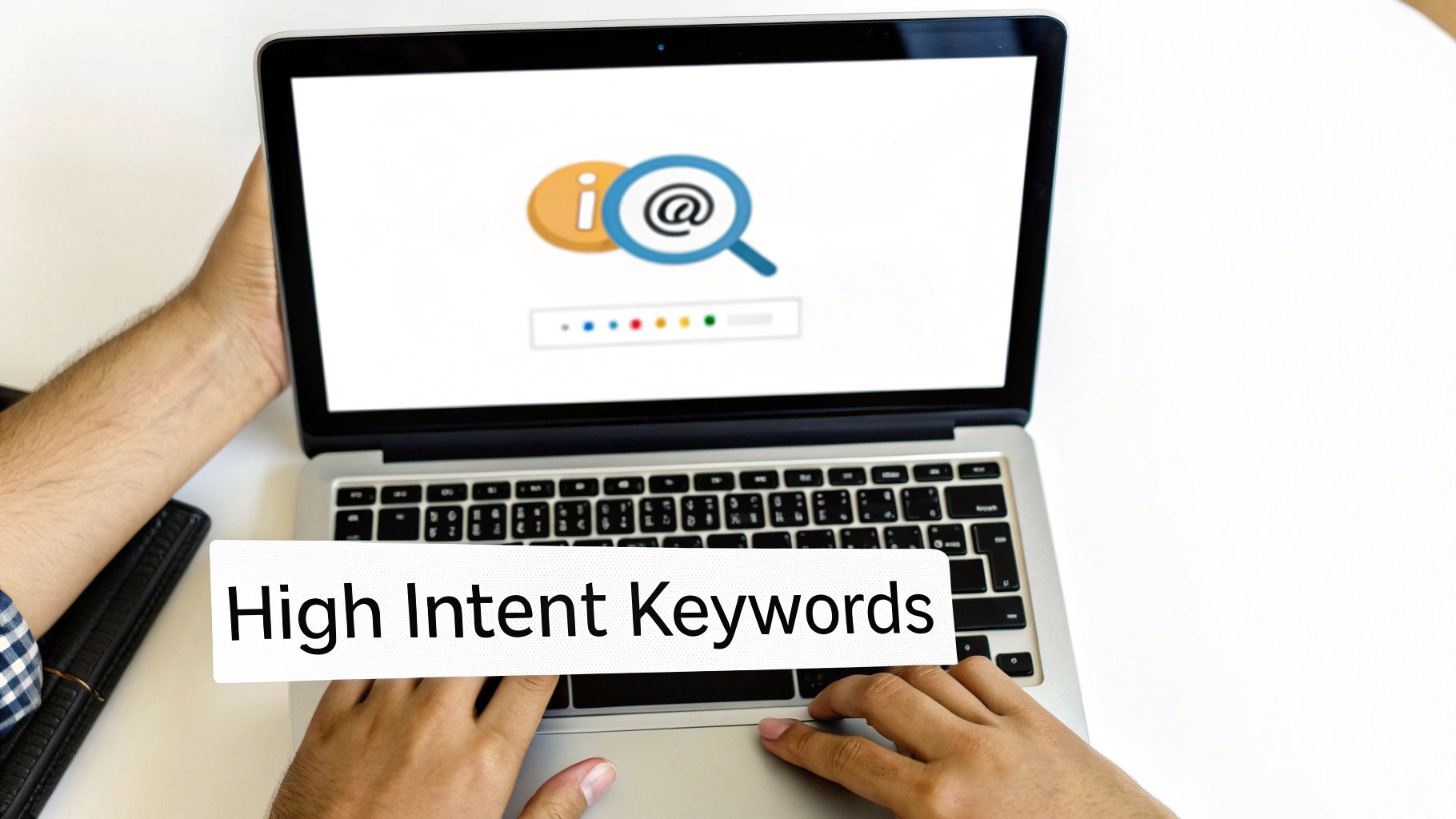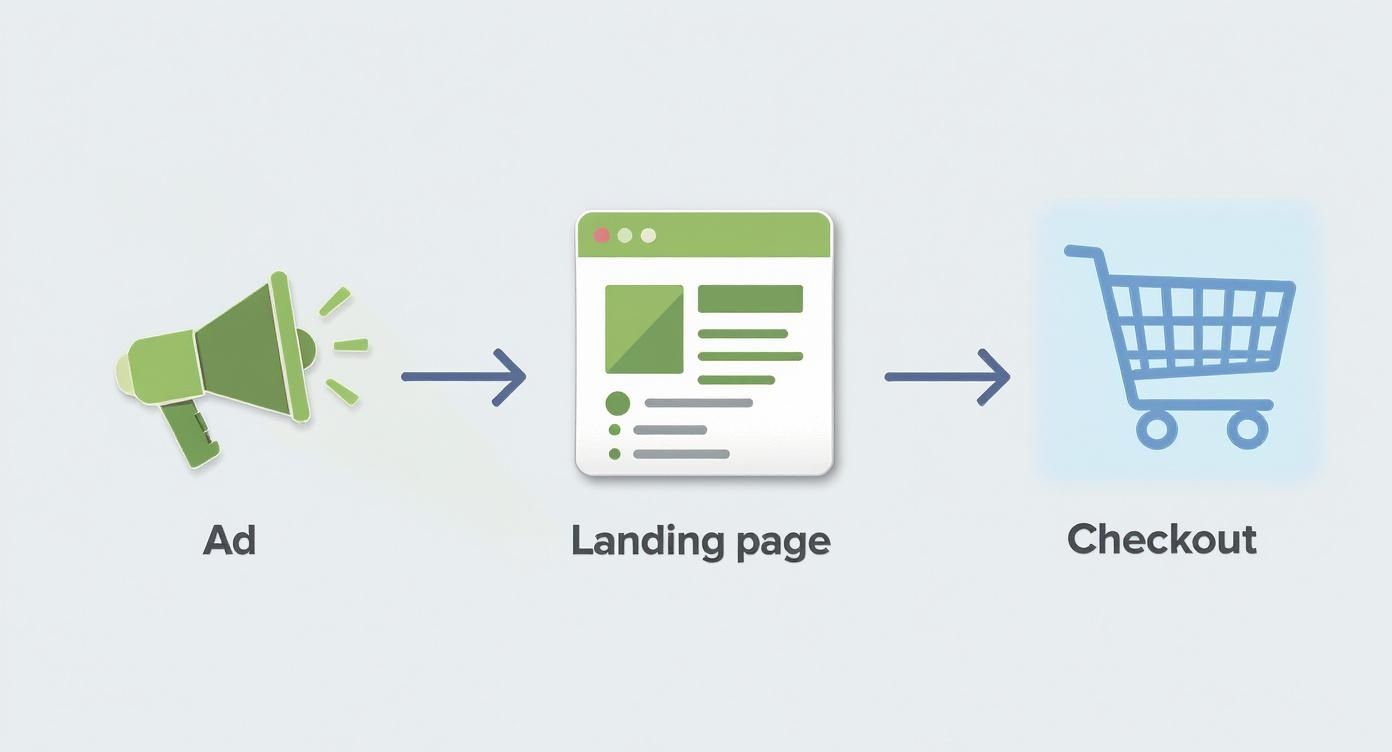Stay Updated with Everything about MDS
Thank you! Your submission has been received!
Oops! Something went wrong while submitting the form.

Chilat Doina
November 8, 2025
E-commerce PPC is pretty simple on the surface: you run paid ads on platforms like Google or social media to get targeted traffic to your online store. It's the most direct way to put your products in front of people who are already looking for them. Done right, it's one of the fastest ways to boost sales and get your brand noticed.

Before you even think about spending a dollar, you need a solid plan. I've seen too many brands rush into creating ads without a clear strategy, and it's a surefire way to burn through your budget with almost nothing to show for it. This initial groundwork is what separates the campaigns that barely break even from the ones that become high-growth engines, consistently delivering returns.
And the first step isn't what you think. It's not about keywords—it's about knowing who you're up against.
First things first, identify your top three to five direct competitors. I’m talking about the brands selling similar stuff to the same people you are. Once you have your list, it's time to do some digging.
Tools like SEMrush or SpyFu are great for this. They can show you what keywords your competitors are bidding on, how they structure their ad copy, and even give you a ballpark estimate of their monthly ad spend.
As you look, keep an eye out for patterns:
The goal here isn't to copy them. It's about learning from their wins and losses to find an angle where your brand can offer something different or, even better, something superior.
Key Takeaway: A thorough competitor analysis is your strategic shortcut. By understanding their playbook, you can identify market gaps, refine your messaging, and allocate your budget more effectively from day one.
Every single click you pay for needs to have a purpose. Without clear goals, you're just guessing. You have no way to actually measure success or make smart decisions. Vague goals like "increase traffic" are useless. Your objectives have to be specific, measurable, and tied directly to your business’s bottom line.
For an e-commerce store, profitability is usually the name of the game. Here are a few concrete examples of goals you should set:
These metrics are what turn your PPC efforts from a simple expense into a measurable, scalable investment. To really nail down these fundamentals, it’s worth checking out a comprehensive guide on Ecommerce PPC.
One of the first questions everyone asks is, "How much should I spend?" The honest answer is: it depends. It's based on your goals and how crowded your market is. But a good rule of thumb is to set a budget that’s big enough to actually collect some meaningful data.
You need enough clicks to see what's working and what isn't.
A budget that allows for at least 10-20 clicks per day on your main campaigns is a reasonable place to begin. This gives the ad platforms enough data to start their optimization process, and it gives you enough information to make smart adjustments. Think of this initial budget as an investment in learning. You're essentially paying for data that will fuel your profitability down the road and help you scale intelligently.

A winning e-commerce PPC strategy isn’t about casting a wide net and hoping for the best. It’s about precision. You need to connect your products with the exact people who are pulling out their wallets, ready to buy. This is where meticulous keyword selection and sharp audience targeting turn your ad spend from a gamble into a direct line to your ideal customer.
Forget just targeting broad terms like "running shoes." That’s a surefire way to burn through your budget. The real money is in finding high-intent keywords that signal someone is in purchase mode, not just window shopping.
High-intent keywords are the specific phrases people type when they're getting serious. They’re usually longer and way more descriptive, spelling out exactly what they want. Just think about the difference between a search for "men's boots" versus "men's waterproof leather hiking boots size 11." That second person isn't messing around—they know what they need and are far more likely to convert.
These super-specific, multi-word phrases are what we call long-tail keywords. While they don't have the massive search volume of broader terms, their collective traffic is huge, and the conversion rates are in another league. In fact, studies show that long-tail keywords can have a click-through rate 3-5% higher than generic searches.
So, how do you find these little gems?
When you focus on these phrases, you attract a much more qualified audience, which naturally leads to a better return on your investment. If you're on a major marketplace, you can learn more about finding the right long-tail keywords for Amazon and apply those same principles to your own campaigns.
Okay, so you’ve got your keywords. Don’t make the rookie mistake of dumping them all into one giant ad group. An effective e commerce ppc strategy relies on tightly themed ad groups. This structure is mission-critical for getting a high Quality Score from Google, which directly impacts your ad costs and positioning. A higher score means you pay less for better spots.
The key is to structure your ad groups around specific product categories or even individual products.
For instance, if you're a kitchenware brand, your ad groups might look something like this:
CampaignAd GroupExample KeywordsCoffee MakersDrip Coffee Makers"12-cup drip coffee maker," "buy black coffee machine"Coffee MakersEspresso Machines"home espresso machine sale," "cappuccino maker reviews"BlendersPersonal Blenders"single serve smoothie blender," "best personal blender"
This tight organization makes your ads hyper-relevant. When someone searches for an espresso machine, they see an ad specifically for espresso machines—not a generic ad for "kitchen appliances." That relevance is what drives a higher click-through rate and, ultimately, more sales.
Expert Tip: Don't sleep on negative keywords. Be proactive and add terms you don't want to show up for. If you sell premium coffee makers, you'd want to add "cheap," "used," or "free" as negative keywords to stop wasting money on clicks that will never convert.
Keywords get you in front of the right search, but audience targeting makes sure you’re reaching the right person. This is where you can get incredibly sophisticated and move way beyond simple demographics.
Think of it as adding layers of intelligence to your campaigns. Here are a few powerful strategies to put into play:
By layering these audiences on top of your keyword-targeted campaigns, you create a powerful one-two punch. You're showing ads to people who are not only searching for what you sell but also perfectly match the profile of your most profitable customers. This is what separates a decent campaign from a truly great one.
A brilliant keyword strategy gets you in front of the right audience, but that's only half the battle. Your ads and landing pages are where the real persuasion happens—they have to seal the deal.
Think of it as a seamless journey you’re building, one that guides a potential customer from a casual click straight through to a confident purchase. It's a two-part equation: the ad has to earn the click, and the landing page has to earn the sale. Getting one right without the other is like having a beautiful storefront with a jammed door. You'll get plenty of window shoppers, but nobody's coming inside to buy.
Your ad is your digital handshake. In just a few lines of text or a single image, you have to grab attention, scream value, and convince someone to stop their endless scrolling. Every platform, whether it's Google or a social media feed, has its own rules of engagement.
For a Google Search ad, for example, it all comes down to hardcore relevance and a crystal-clear call-to-action (CTA). Your headline needs to be a near-perfect mirror of what the user just typed into the search bar. The description's job? To immediately answer their unspoken question: "What's in it for me?"
Let's break down the essential ingredients:
When you're on visual platforms like Google Shopping or social media, your product image is the undisputed hero. It needs to be high-quality, well-lit, and show the product without any distractions. Pro tip: Don't be afraid to A/B test lifestyle shots against those clean, white-background images. You might be surprised what your audience responds to.
Okay, so they clicked your ad. Awesome. But the journey is only halfway over. The landing page must deliver on the promise your ad just made. This is a concept we call ad-to-page congruence, and it’s completely non-negotiable if you want high conversion rates.
If your ad screams "50% Off Summer Sale," your landing page better have a massive banner echoing that exact same offer. Any mismatch, any disconnect at all, creates friction. That friction leads to confusion, and confused visitors hit the "back" button faster than you can say "wasted ad spend."
Your landing page shouldn't just be a continuation of the ad; it should be its logical conclusion. The headline, imagery, and core message must align perfectly to build trust and maintain the momentum you worked so hard to create.
This alignment is a foundational principle of good marketing. In fact, making sure your ad and landing page speak the same language is one of the easiest wins in PPC. It's a core tenet you can explore further by reading up on conversion rate optimization best practices.
Your product page is your final, most important sales pitch. It needs to be clean, trustworthy, and incredibly easy to use. Every single element should be laser-focused on reducing hesitation and guiding the user's mouse straight to that "Add to Cart" button.
Look at what’s happening in the market right now. As of early 2023, over 30% of products in PPC campaigns were discounted. That’s a significant jump from the year before, signaling a clear trend: promotions are a key lever for driving sales in a crowded space. You can dig into more of these ecommerce advertising statistics and trends on Userguiding.com. The takeaway is simple: if you're running a sale, make it the most prominent thing on the page.
Your landing page isn't just a product showcase; it's a conversion machine. Here’s a checklist of the essential components every high-performing page needs to have.
ElementPurposeBest Practice ExampleHigh-Quality ImageryTo help customers visualize the product and build genuine desire.Multiple angles, a zoom feature, and in-context lifestyle photos or even a short video.Clear, Compelling CTATo guide the user to the next step without a single moment of doubt.A brightly colored "Add to Cart" button that visually pops off the page. No ambiguity.Social ProofTo build trust and show that other real people absolutely love your product.Displaying star ratings, customer reviews, and testimonials prominently near the product title.Simple Checkout ProcessTo slash cart abandonment by making the purchase process fast and painless.Offering guest checkout and keeping the number of form fields to an absolute minimum.
By making sure your ads are irresistible and your landing pages are congruent and optimized, you create a powerful, cohesive system. This seamless experience doesn't just attract traffic; it turns clicks into loyal customers, maximizing the return on every single dollar you spend.
Launching your e-commerce PPC campaign is a huge milestone, but it's really just the starting line. The real profit and long-term success are found in what comes next: the relentless cycle of monitoring, optimizing, and intelligently scaling. This is your playbook for turning a good campaign that gets some clicks into a fine-tuned revenue machine.
This process is all about turning paid traffic into loyal customers. The visual below breaks down the fundamental flow, from that first ad click all the way to the final sale.

This simple journey highlights the critical handoff points where your optimization efforts can stop potential customers from dropping off.
Profitable campaigns are built on data, not guesswork. You have to set aside time each week to dive into your key performance indicators (KPIs). Don't just glance at them; understand the story they're telling you about your customers and your ads.
Your core metrics dashboard should include:
Once you have a baseline, it's time to start A/B testing. This is simply running two versions of an ad or landing page at the same time to see which one performs better. Start by testing just one variable at a time for clear results. Test your headlines, your calls-to-action, your product images, or even your promotional offers. A simple change like swapping "Buy Now" for "Shop The Collection" can have a surprising impact on your CTR.
The search query report is arguably the most powerful tool in your optimization arsenal. It shows you the exact search terms people typed into Google before clicking your ad. This is unfiltered customer insight, and it's an absolute goldmine.
Regularly reviewing this report helps you achieve two main goals:
Pro Tip: Don't just look for single-word negatives. Look for patterns. If you see searches for "jobs," "how to," or "DIY," you're likely attracting researchers, not buyers. Adding these types of terms can dramatically improve the quality of your traffic overnight.
Scaling isn't just about cranking up your budget. Doing that without a plan will only amplify your losses. Smart scaling is a methodical process based on proven performance—you should only ever scale what is already working.
Here’s a clear framework to follow:
For brands looking to dive deeper into the nuances of this process, exploring advanced resources on PPC campaign optimization can provide additional strategies to refine your approach. Remember, the goal is to grow your reach without sacrificing profitability. Optimization and scaling are two sides of the same coin—one refines your engine, and the other adds more fuel.
What worked in paid search yesterday is already old news. To stay ahead of the curve, you have to constantly adapt to new tools, privacy rules, and ad formats that are reshaping the entire industry. This isn't just about tweaking a few bids anymore; it's about fundamentally changing how you structure campaigns and define success.
Right now, two massive shifts are redefining the e-commerce PPC world: the rise of all-in-one, AI-driven campaign types and the slow, inevitable death of third-party cookies. Getting a handle on these changes is the key to future-proofing your ad strategy and keeping your edge.
Google's Performance Max (PMax) is a huge departure from the old way of doing things. Instead of micromanaging separate Search, Shopping, Display, and YouTube campaigns, PMax rolls them all into a single, goal-focused campaign. It then uses AI to hunt for converting customers across every corner of Google's network.
For a lot of store owners, this is a game-changer. It dramatically simplifies how you manage campaigns and can uncover new customer segments you’d never find on your own. But don't be fooled—this is not a "set it and forget it" solution.
To really make PMax sing, you need to feed the algorithm high-quality ingredients:
Think of PMax as a powerful new player on your team, not a replacement for your entire playbook. It often delivers the best results when it runs alongside a dedicated branded search campaign, which protects your brand traffic while PMax goes out and finds new customers. As you explore modern trends, it's also worth understanding what TikTok Spark Ads are, since they use authentic user content to expand your reach on another massive platform.
The other earthquake shaking the industry is the phase-out of third-party cookies. This completely changes how you track conversions and build remarketing audiences, making the old method of following users across the web unreliable. The entire global search advertising market, which is on track to hit $351.55 billion in 2025, is scrambling to adapt.
Even though businesses typically earn $2 for every $1 invested, nearly half of all marketers are finding it much harder to manage campaigns because of these privacy updates. This shift means one thing above all else: your own first-party data is now your most valuable asset.
Key Insight: In a post-cookie world, the brands that win will be the ones with the strongest direct customer relationships. Your email list, customer accounts, and site analytics are no longer just marketing tools; they are the foundation of your future advertising efforts.
To get ready, you need to zero in on two critical areas:
By embracing AI-powered campaigns and building a rock-solid first-party data strategy, you can successfully navigate the new rules of e-commerce PPC. This proactive approach will keep your advertising effective, profitable, and resilient for years to come.
Getting into e-commerce PPC can feel like you're trying to solve a puzzle with a million pieces. If you're new to the game, you're not alone in wondering about budgets, what "good" performance actually looks like, or where to even start with your campaigns.
Getting a handle on these common questions is the first real step toward building an advertising plan that actually makes you money instead of just costing you.
Let's break down a few of the most frequent questions we get from store owners.
This is the big one, but there's no single magic number. A solid rule of thumb is to set a budget that allows for at least 10-20 clicks per day on your most important campaigns.
Why? Because in the beginning, you're not buying sales—you're buying data.
Think of it this way: you can't tell if an ad is a winner or a dud with just a handful of clicks. A tiny budget gives you murky results, leaving you guessing about what to do next. It’s much smarter to focus a healthy budget on a couple of your core products, prove you can get a positive return, and then scale up with confidence.
What counts as a "good" Return on Ad Spend (ROAS) completely depends on your business and, most importantly, your profit margins. People love to throw around 4:1 ($4 back for every $1 spent) as the industry benchmark, but that's just a starting point.
Here’s a more realistic look:
Before you spend another dollar, calculate your break-even ROAS. This is the absolute minimum you need to make back to not lose money. Your real goal is to blow past that number.
For almost any e-commerce store, the answer is a resounding both. They work together, catching customers at different points in their journey. It's not an either/or situation.
Google Shopping Ads are the visual powerhouses at the top of the search results. They’re perfect for grabbing the attention of people who are in "buy mode" and actively comparing products.
Classic Search Ads, on the other hand, are your sharpshooters. They let you target super-specific, long-tail keywords, show up for your own brand searches, and answer direct questions people are typing into Google. Using them in tandem creates a net that catches demand from every possible angle.
At Million Dollar Sellers, we know that cracking the PPC code is just one piece of the e-commerce puzzle. Our exclusive community is where top founders connect to share the playbooks that are working right now, helping you scale faster and with more profit. Discover how MDS can accelerate your growth.
Join the Ecom Entrepreneur Community for Vetted 7-9 Figure Ecommerce Founders
Learn MoreYou may also like:
Learn more about our special events!
Check Events